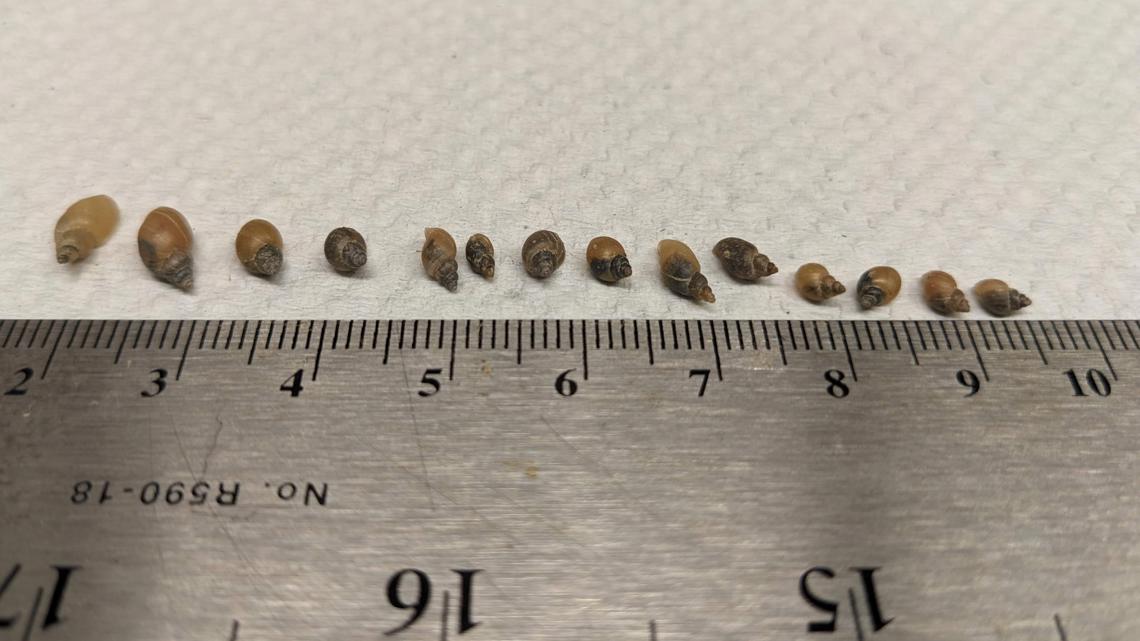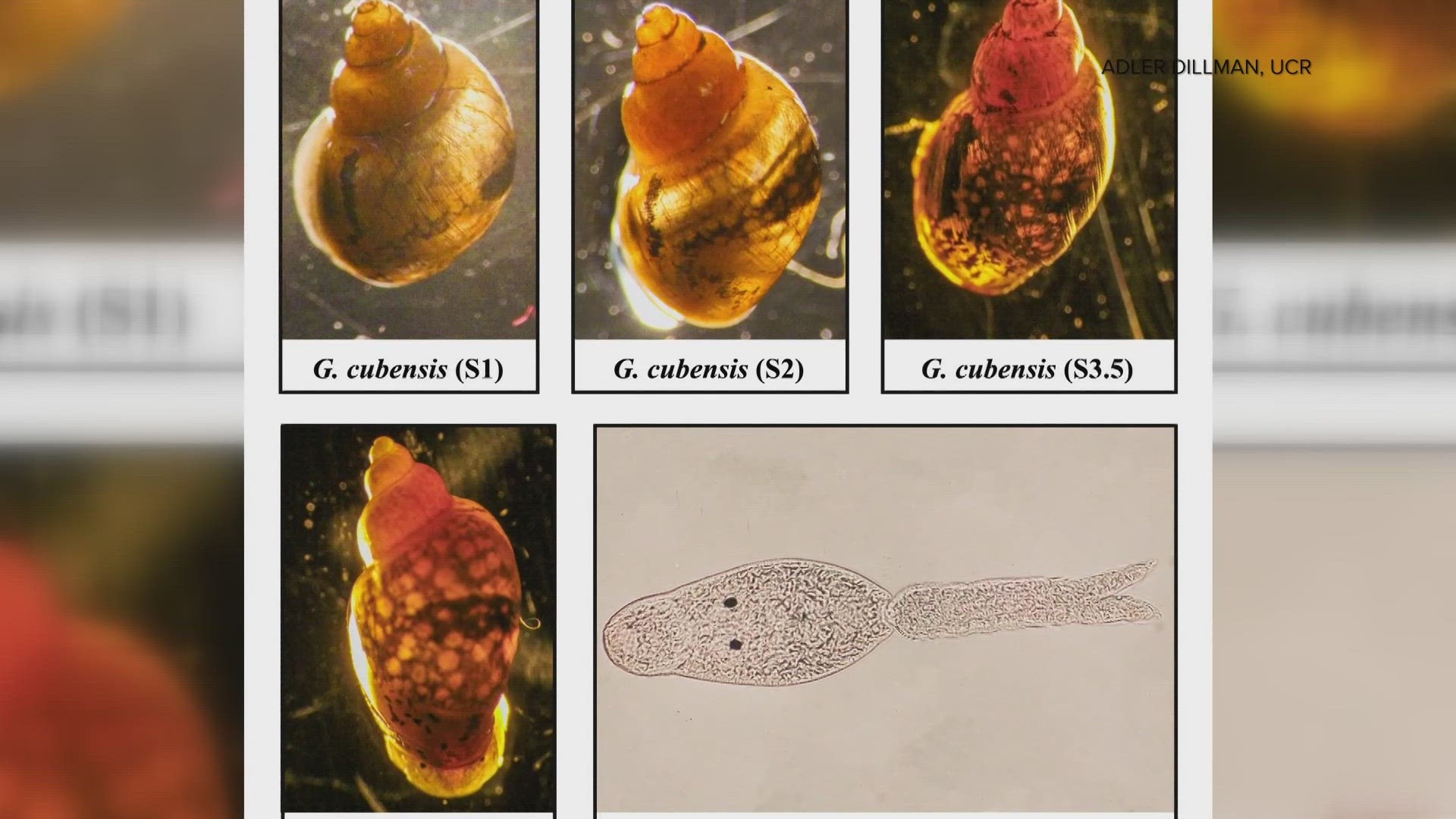ARIZONA, USA — A parasitic worm usually restricted to Gulf Coast states has been found in the Colorado River, and it can kill your dog.
Scientists with UC Riverside confirmed the presence of the parasite — one of many flatworms known as liver flukes — on the banks of the Colorado River in southern California. Veterinarians in the area sounded the alarm when several dogs came down with unusual infections over the last five years.
The liver fluke, Heterobilharzia americana, causes a condition known as canine schistosomiasis when it infects a dog. Its "gradual, insidious onset" first appears as lethargy and weight loss, but eventually causes severe liver and intestinal disease that can be fatal without treatment.
Infections happen when the dog comes into contact with the parasite by drinking or swimming in infested water. The free-swimming parasite burrows through the dog's skin and tissues where it moves into veins near the lungs, intestine and liver until it matures inside the dog.
"The good news is, it takes a long time for symptoms to begin showing for this infection. And before any serious damage is done, it's easy to diagnose," UC Riverside Department of Nematology chair Adler Dillman explained. "It's easy to treat. There are a number of drugs that are very effective at killing this parasite."


Symptoms can take six to eight weeks to show up after exposure, Dillman said. If you and your dog have been swimming in the Colorado River, you should watch for the following symptoms:
- Lethargy
- Loss of appetite
- Weight loss
- Diarrhea
- Bloody stool
- Vomiting
If your dog is showing these symptoms, seek veterinary assistance. Note the exact location of the body of water your dog was swimming in. Fortunately, the parasite cannot be directly passed from one dog to another and the disease is treatable if caught early.
"This is about mitigation of risk. How risk averse are you as a pet owner?" Dillman said, "This is not something where I would tell everybody 'don't get in the water anymore! Don't let your dogs get in the water!' It's up to you and if your dog does get infected, it's not a death sentence — it can be diagnosed and it can be treated."
So far, veterinarians in southern California have recorded 11 cases over the last five years. However, as the parasite's presence wasn't confirmed in the river before now it's likely that there were more unreported cases.
Where is the parasite found?
The parasite was found in the Colorado River near Blythe, California which is where Interstate 10 crosses the river.
Typically, H. americana is only found in southeastern states like North Carolina, South Carolina, Georgia and Gulf Coast states like Florida, Louisiana and eastern Texas. It's unusual to see them as far west as the Colorado River, scientists noted.
These parasites require freshwater environments like mud flats, ponds, lakes and rivers as well as certain kinds of snails. After the worm's eggs hatch in water, a free-swimming juvenile form infects those snails, then develops into a more adult form and is released back into the water. At this point, it will infect its definitive host — usually raccoons, though infections have been seen in many other species — where it will mature, lay eggs and die inside the host's body.


Right now, the full range of the parasite in the Colorado River is uncertain. Similar infections were found as far north as Moab, Utah, Dillman said.
"It seems likely to me that the parasite may be in the Colorado River up that far north as well, and we'd like to go and confirm that," Dillman explained. "We'd also like to see if it's then running the full length from at least Moab to the Gulf."
He and his team will prioritize checking places that are popular for tourism.
Can it infect humans?
Kind of.
While human immune systems are equipped to deal with the parasite and prevent serious illness, liver flukes are known to cause the localized rash known as "swimmer's itch" when they burrow through human skin.
"What's special about our relationship to this parasite is it hasn't evolved to affect people," Dillman explained. "It's evolved to infect other mammals, and lucky for us we don't have versions of this parasite in the United States that can infect people."
The rash eventually goes away on its own and can be treated with topical creams.
What's next?
Dillman and his team are still working to determine the full range of the species in the Colorado River. Once they have that knowledge, they can start taking steps to combat the invasive worm.
"I just want to reiterate, this is not meant to scare or terrify anybody. Nobody should be afraid of this parasite," Dillman said. "Knowledge is power and knowing that there is a potential risk when you take your dog for recreation, that's good to know."
>> Download the 12News app for the latest local breaking news straight to your phone.
UP TO SPEED
Catch up on the latest news and stories on our 12News YouTube playlist here.

